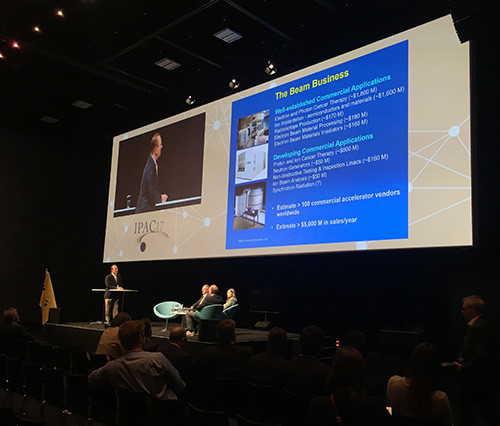
Robert Kephart of Fermilab speaking about the “beam business” at IPAC17.
By Margaret Harris at the International Particle Accelerator Conference in Copenhagen
Normally, you’d expect a particle-accelerator conference to focus on research – either the fundamental research done at accelerator facilities around the world, or the applied research required to get such facilities up and running in the first place. And for the most part, that has been absolutely true of the 8th International Particle Accelerator Conference (IPAC), which is taking place this week on the outskirts of Copenhagen, Denmark.
On Tuesday, however, the conference organizers dedicated a session to the ways that accelerator science engages with industry. In a two-hour series of talks, audience members heard from speakers as varied as Bjerne Clausen, CEO of the Danish chemical technologies firm Haldor Topsoe; Bob Kephart, director of the Fermilab-affiliated Illinois Accelerator Research Center (IARC); and Giovanni Anelli, who leads the Knowledge Transfer group at CERN.
For me, Kephart’s and Anelli’s talks were the most interesting. I knew a little about IARC already, having interviewed Kephart about it on a visit to Fermilab back in 2011, so it was nice to hear an update. The most exciting project Kephart mentioned was an effort to develop a superconducting radio-frequency accelerator that would be mobile enough to, in his words, “take the accelerator to the problem rather than the other way around”. This, he explained, would open up a host of new applications in medicine and environmental decontamination.
Conversely, Anelli’s talk gave me a chance to learn something completely new, since its subject – CERN’s strategy for disseminating the intellectual property generated by its employees – was not something I’d thought about before. In general, Anelli explained, CERN tends not to patent its inventions, preferring a more “open” approach. However, it does make exceptions for technologies that are unlikely to find their way to market without patent protection. Anelli also pointed out that part of CERN’s mission is to provide “industrial return” for the lab’s member states – again, not something I knew previously.
As for Clausen, he appeared in a panel discussion on “Industry as a Career Path for Physicists”. This could have been a great session, but unfortunately, Clausen was the only person on the panel who had, er, actually spent his career in industry. (The other two panellists, Hans Arno Synal and Carsten Welsch, are perhaps best described as industry-friendly academics, since they hold professorships at ETH Zurich and the University of Liverpool, respectively.) The panel’s lopsided make-up may be why there wasn’t much substantive advice during the session about such things as how to prepare for an industry career, what kinds of roles a physicist might hold at a hi-tech company, or indeed why (aside from a higher salary) a career in industry should be an attractive option in its own right, not just a fall-back if academia doesn’t work out.
I don’t want to be too critical of the conference organizers on this, since including an industry session in a largely academic-focused conference is a positive step, and I’m sure some of the students in the audience benefited from learning that some physicists do go into – whisper it! – industry rather than academia. But for students who want more information than this, here is my advice for future conferences: if you are pressed for time, skip the token “industry” session and pay a visit to the exhibition hall. There, you will find representatives of dozens or even hundreds of companies that cater to researchers in your field. Most of these people will have some kind of scientific background, and if they aren’t too busy talking to potential customers, they will be more than happy to speak to you about what they and their colleagues do. They may also know whether their company is recruiting right now and if so, for what positions. All of this is exactly the kind of information you need if you are serious about pursuing a career outside the university environment – as, indeed, many of you certainly should be. After all, as Clausen put it, “If you choose the right industry, you may get the chance to solve some of the big challenges the world is facing.”
Guidelines
Show/hide formatting guidelines
this text was deletedwhere people live in harmony with nature and animals</q>
Some text